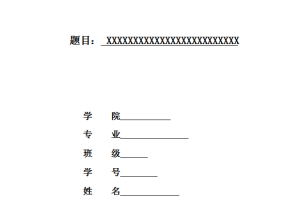摘要
本研究主要围绕人力资本跨区域流动对区域经济发展的影响进行分析。随 着新经济增长理论的兴起与发展,人力资本跨区域流动逐步成为区域经济发展 的重要影响因素,人力资本对经济增长的重要作用越来越受到关注,人力资本 流动对区域经济发展的影响也越来越显著。因此,对人力资本流动对区域经济 发展的影响进行测度分析具有重要的的理论意义和现实意义。本研究着重强调 人力资本跨区域流动能够促进区域经济的健康、协调发展。本文在现有研究和 理论梳理的基础上,根据实际经济数据,对万州区流动的人力资本存量进行了 测算,并对流动的人力资本对经济增长的贡献进行了测度分析。
首先,本研究采用受教育年限法对1999一2009年万州区流动的人力资本存 量进行了测算。
其次,采用生产函数模型具体测算了万州区人力资本对经济增长的实际贡 献。对模型的估计结果显示,物质资本、劳动和流动的人力资本统计检验都是 显著的,产出弹性分别为0.8187、1.2448和0.7314,这表明物质资本、劳动和 流动的人力资本投资的增加均会带来产出的相应增加。在此基础上运用模型对 各要素的贡献率进行了测度,结果显示:物质资本对万州经济增长的贡献率最 高,达到了 72.69%,人力资本次之为19.21%,其中流入的人力资本的贡献率则 为6.34%。在人力资本中,流入的人力资本对万州区经济增长贡献率较大。
依据以上测度结果,对万州区人力资本流动存在的问题进行了深入分析, 并提出了基于人力资本流动的万州区经济发展对策。
关键词:人力资本流动;区域经济增长;万州区
Abstract
This research is based on the impact of human capital cross-regional flow upon regional economic development in our country. Along with the emergence and development of the new economic growth theory, the effect of human capital on the economic growth has been given increasingly more attention. The impact of cross-regional human capital flow on regional economic growth has been even more significant. The cross-regional human capital flow is an important factor affecting regional economic growth in our country. The analysis of the above two enjoys great theoretical and realistic significance. The point that human capital flow would facilitate the all-round, balanced and sustainable development of the regional economic development in our country is an emphasis of this research. On the basis of literature review as well as the economic data available, the stock of human capital in Wanzhou District is measured, and its contribution to economic growth is analysed.
First, the method of years of schooling is adopted to analyze the stock of human capital flow in Wanzhou District from 1999 to 2009.
Next, the production function model is employed to measure the actual contribution of human capital flow of Wanzhou to local economic growth.
According to the result of the measurement, the statistic feedback of material capital ,labor capital and human capital flow prove to be notable. The value of output flexibility is 0.8187、1.2448 and 0.7314 respectively, which shows that the increase of investment of the above three would bring about a rise of the output accordingly. Based on this, the contribution rate of these three factors is measure by the model. The result is as below: material capital accounting for 72.69% outweigh the other two, followed by human capital (19.21%) in which the in-flowing part takes up 6.34% for the contribution. The in-flowing human capital contributes the most among all the factors of human capital for the economic growth in Wanzhou.
In the light of the result of the above measurement, the problems concerning human capital flow in Wanzhou are deliberated and approaches of Wanzhou5s economic development based on human capital flow are put forward.
Key Words: Human Capital Flow; Regional Economic Growth; Wanzhou District
摘要……………………………………………………………………………………… 工
Abstract ………………………………………………………………………………… ii
第1章导论……………………………………………………………………………… 1
- 研究的背景与意义…………………………………………………… 1
1.1.1研究背景………………………………………………………………. 1
1.2研究的方法、相关概念界定……………………………………………… 3
1.2.2相关概念界定………………………………………………………… 4
1.3研究的基本内容与论文的框架结构…………………………………….. 5
1.3.1研究的基本内容……………………………………………………… 5
1.3.2论文的框架结构……………………………………………………… 5
1.4论文的创新之处……………………………………………………………… 6
第2章国内外相关理论研究的文献综述……………………………………….. 7
2.1人力资本流动理论研究的述评…………………………………………… 7
2.1.1人力资本流动理论的综述………………………………………… 7
2.1.2人力资本流动理论的评价………………………………………… 8
2.2区域经济增长理论研究的述评…………………………………………… 8
2.2.1国内区域经济增长理论研究综述………………………………. 8
2.2.2国内区域经济发展理论研究评价………………………………. 9
2.3.1人力资本流动与区域经济贡献的理论研究综述……………. 9
2.3.2人力资本流动与区域经济贡献的理论研究评价…………. 10
第3章人力资本流动与区域经济增长的理论模型………………………… 12
3.1生产函数模型选择………………………………………………………… 12
3.1.1柯布-道格拉斯(Cobb-Douglas,C-D)生产函数…………… 12
3.1.2超越对数生产函数……………………………………………….. 12
3.1.3生产函数选择……………………………………………………… 13
3.2考虑人力资本的生产函数模型………………………………………… 13
3.2.1有效劳动模型……………………………………………………… 13
3.2.2人力资本外溢模型……………………………………………….. 13
第4章人力资本流动对万州区经济增长影响的实证分析………………. 14
4.1万州区人力资本流动的现状与存量测度…………………………… 14
4.1.1人力资本测量方法………………………………………………… 14
4.1.2万州区人力资本流动现状……………………………………….. 15
4.1.2.1万州区教育总规模…………………………………………. 15
4.1.2.2各级教育发展情况…………………………………………. 16
4.1.2.3万州区就业人员受教育程度情况……………………… 16
4.1.3万州区流动的人力资本测度……………………………………. 16
4.3人力资本流动对万州区经济增长影响的实证分析………………. 24
4.3.1模型估计及检验……………………………………………………. 24
4.3.2人力资本流动对万州区经济增长贡献率的测度………….. 25
第5章人力资本流动对万州区经济发展影响的问题与对策……28
5.2基于人力资本流动的万州区经济发展对策………………………… 28
5.3有待进一步研究的问题及展望………………………………………… 30
参考文献……………………………………………………………………………… 31
附录:作者攻读硕士学位期间发表论文及科研情况……………………. 34
致谢……………………………………………………………………………………. 34





